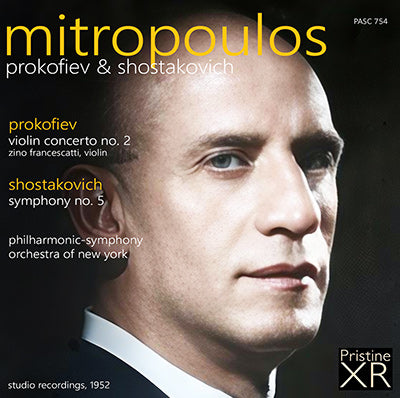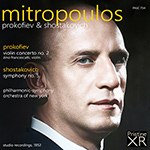
This album is included in the following sets:
This set contains the following albums:
- Producer's Note
- Full Track Listing
- Cover Art
Dmitri Mitropoulos in New York: Prokofiev and Shostakovich (1952)
The two recordings presented here, both set down in 1952 at Columbia’s famed 30th Street Studio, capture the dynamic partnership between Dimitri Mitropoulos and the Philharmonic-Symphony Orchestra of New York during a period of remarkable artistic vitality. Though very different in style and emotional climate, Prokofiev’s Violin Concerto No. 2 in G minor and Shostakovich’s Symphony No. 5 in D minor share a sense of tension between private feeling and public utterance — a conflict Mitropoulos was uniquely able to reveal.
By 1952, Mitropoulos was in his fourth season as the orchestra’s music director, a post he had assumed in 1949 following a distinguished decade with the Minneapolis Symphony. His conducting combined fierce intellectual clarity with an almost mystical intensity of expression. A devout man with little concern for worldly display, he threw himself wholly into the music, conducting without baton and often without a score. Critics sometimes found his approach overwhelming; musicians, while challenged, often spoke of the profound sense of involvement he drew from them. Columbia Records, meanwhile, was keen to document his work in both the concert hall and the studio, making the present recordings valuable documents of his New York tenure.
Prokofiev: Violin Concerto No. 2 in G minor, Op. 63
Zino Francescatti, violin — recorded 27 October 1952
Prokofiev’s Second Violin Concerto dates from 1935, a period of stylistic consolidation just before his final return to Soviet Russia. In contrast to the glittering modernism of his First Concerto and the ironic brilliance of the Classical Symphony, the Second reveals a new lyricism and warmth — a neoclassical clarity tinged with wistfulness. Its themes are simple but haunting, its orchestration transparent, its harmonies tinged with a bittersweet ambiguity that would colour much of Prokofiev’s later work.
Zino Francescatti was one of the most refined violinists of his generation, admired for the silken beauty of his tone and the effortless grace of his phrasing. His collaboration here with Mitropoulos is a meeting of two strong musical personalities perfectly attuned to the work’s contrasting moods. The opening movement’s restless oscillation between melancholy and animation is shaped with a keen sense of line and structure. Francescatti’s playing combines elegance with steel, the cadenza integrated seamlessly into the musical argument.
In the central Andante assai, one of Prokofiev’s most memorable slow movements, the soloist’s lyrical eloquence finds an ideal partner in Mitropoulos’s sensitive support — the orchestral textures finely balanced, the phrases breathing with unforced naturalness. The finale, with its rhythmic drive and hints of Spanish colour (the concerto was composed for the Franco-Belgian violinist Robert Soetens, and premiered in Madrid), is propelled with irresistible energy. Francescatti’s virtuosity remains poised and crystalline even in the most fiery passages, while Mitropoulos ensures that the orchestral motor never loses its taut precision.
The result is a reading that stands among the most distinguished of its era — less flamboyant than Heifetz’s, less impetuous than Oistrakh’s, but possessed of a Gallic refinement and musical intelligence that reveal new facets of Prokofiev’s artistry.
Shostakovich: Symphony No. 5 in D minor, Op. 47
Recorded 1 December 1952
If Prokofiev’s concerto suggests an artist reconciling personal expression with public expectation, Shostakovich’s Fifth Symphony represents that struggle on an epic scale. Written in 1937 in the shadow of official condemnation for his opera Lady Macbeth of Mtsensk, the symphony was presented as “a Soviet artist’s creative reply to just criticism”. Yet its apparent compliance with socialist-realist ideals — the triumphal finale, the clear tonal framework — conceals a far deeper and more tragic narrative. Beneath the outward heroism lies a sense of anguish and ironic defiance that has continued to provoke debate for decades.
Mitropoulos was one of the first Western conductors to grasp the symphony’s dual nature. His performances, whether in New York, Minneapolis or abroad, were renowned for their visceral intensity and moral conviction. The 1952 recording presented here — made just four years after his famous Carnegie Hall account that electrified American audiences — captures that fervour in concentrated form.
From the opening’s jagged ostinato and bleakly rising string lines, the music unfolds with grim inevitability. Mitropoulos emphasises the symphony’s architectural cohesion, binding its four movements into a single arc of tension and release. The scherzo’s sardonic waltz rhythms bite sharply, yet are never caricatured; the Largo that follows is profoundly moving, the conductor drawing an almost vocal quality from the strings and woodwinds.
The finale’s march to “victory” is delivered with blazing intensity, but Mitropoulos resists empty bombast. His tempo broadens at the close, revealing not triumph but exhaustion — a shattering vision of forced jubilation that anticipates later readings by Bernstein and Mravinsky. The Philharmonic-Symphony Orchestra plays magnificently throughout, its brass section resplendent, its strings united in passionate unanimity.
Legacy
Earlier this year Pristine Classical marked the fiftieth anniversary of Shostakovich’s death with Mitropoulos’s live 1955 Athens performance of the Tenth Symphony, and coupled it with his 1956 studio recording of Prokofiev’s First Violin Concerto featuring Isaac Stern (PASC 748). Together with the present release, these recordings trace a compelling thread through the conductor’s repertoire: his empathy with twentieth-century Russian music, his refusal to simplify its emotional complexity, and his ability to communicate its drama with unflinching honesty.
Mitropoulos’s 1952 studio sessions remind us why he was revered by musicians and audiences alike — a conductor of burning conviction, fearless intellect, and boundless humanity.
PROKOFIEV Violin Concerto No. 2 in G minor, Op. 63
1. 1st mvt. - Allegro moderato (10:17)
2. 2nd mvt. - Andante assai (8:48)
3. 3rd mvt. - Allegro ben marcato (6:23)
Recorded 27 October, 1952
Zino Francescatti, violin
SHOSTAKOVICH Symphony No. 5 in D minor, Op. 47
4. 1st mvt. - Allegro con fuoco (16:52)
5. 2nd mvt. - Grave (5:13)
6. 3rd mvt. - Intermezzo (14:32)
7. 4th mvt. - Finale (Allegro molto) (8:48)
Recorded 1 December, 1952
Philharmonic-Symphony Orchestra of New York
conducted by Dmitri Mitropoulos
XR remastering by Andrew Rose
Cover artwork based on a photograph of Mitropoulos
Recorded at Columbia 30th Street Studios, New York City
Total duration: 70:53

